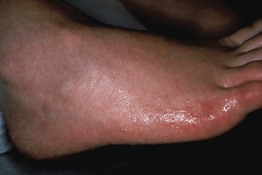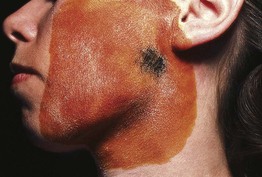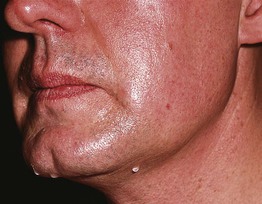32
Disorders of Eccrine and Apocrine Glands
Eccrine and apocrine glands represent the two major types of sweat glands (see Fig. 91.1).
Eccrine Glands
Apocrine Glands
Hyperhidrosis
• Excessive production of eccrine sweat is usually due to primary cortical (emotional) hyperhidrosis and the favored sites are the axillae or palms and soles (Fig. 32.1) > the face (Fig. 32.2); involvement is bilateral and symmetric.

Fig. 32.1 Volar hyperhidrosis (primary cortical). The palmoplantar skin displays excessive eccrine sweat production, including the portions that extend onto the sides of the hands, feet, and digits. Its onset is during childhood as opposed to axillary hyperhidrosis, which has its onset around puberty.
• Secondary hypothalamic (thermoregulatory) hyperhidrosis can be due to a number of systemic diseases, from infections to neoplasms (Table 32.1).
Table 32.1
Causes of secondary hypothalamic hyperhidrosis.

CNS, central nervous system; CVA, cerebrovascular accident; MAOI, monoamine oxidase inhibitor; RSD, reflex sympathetic dystrophy, also referred to as complex regional pain syndrome; SSRI, selective serotonin reuptake inhibitor. Linezolid is an MAOI.
• Secondary medullary (gustatory) hyperhidrosis can be physiologic as exemplified by the facial sweating that occurs with spicy foods or pathologic as occurs in Frey’s syndrome (Fig. 32.3); in the former, taste receptors send afferent impulses, whereas in the latter, disrupted nerves for sweat aberrantly connect with nerves for salivation.

Fig. 32.3 Gustatory sweating in the auriculotemporal (Frey’s) syndrome, as a consequence of parotid surgery. The blue-black area represents sweating (starch–iodine technique). Salivary stimulation induced this sweating response. Reproduced from Hurley HJ. Hyperhidrosis. Curr. Opin. Dermatol
Stay updated, free articles. Join our Telegram channel

Full access? Get Clinical Tree









